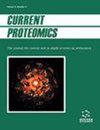Investigating PI3P Binding with Plasmodium Falciparum HSP70 Proteins
IF 0.5
4区 生物学
Q4 BIOCHEMICAL RESEARCH METHODS
引用次数: 0
Abstract
aims: Investigating the binding of phosphatidylinositol 3 phosphate (PI3P) with Plasmodium falciparum heat shock protein 70 homologs background: The 70 kDa Plasmodium falciparum (Pf) heat shock proteins (PfHSP70s) are an important class of molecules that are critically involved in parasite survival through periods of stress. Interaction between a crucial lipid modulatorPI3P and the C terminal lid domain of cytosolic PfHSP70-1, stabilizes the parasite digestive vacuole (DV) to facilitate hemoglobin trafficking and breakdown in turn impacting parasite survival. PfHSP70 homologs and PI3P are amply expressed together in various subcellular compartments of the parasite providing these with an opportunity to interact and affect biological processes. objective: The objectives of this study included identification of the PI3P binding pockets on PfHSP70s, understanding the binding affinity of each homolog for PI3P and identifying residues involved in different types of interactions. method: We have analyzed PI3P binding of all four PfHSP70s by using bioinformatics tools like sequence analysis, molecular docking and LigPlot+ analysis. result: Our results show that differently localized PfHSP70 homologs bind PI3P with variable affinity. The mitochondrial and ER localized PfHSP70s bind more strongly with PI3P than their cytosolic counterpart PfHSP70-1. The PI3P binding region on all PfHSP70 homologs lies at the interface of helices 1 and 3 of their substrate binding domain . Analysis of these results has also helped to pinpoint specific residues on PfHSP70s that may be engaged in these interactions. conclusion: PI3P preferentially binds to a particular pocket on PfHSP70 homologs. Different PfHSP70s bind to PI3P with variable binding affinity. Specific residues of PfHSP70 homologs involved in these interactions have been identified. other: The present study may therefore form the basis for designing interventions that hinder PfHSP70-PI3P interaction and influence parasite survival.研究 PI3P 与恶性疟原虫 HSP70 蛋白的结合
目的研究磷脂酰肌醇 3 磷酸酯(PI3P)与恶性疟原虫热休克蛋白 70 同源物的结合背景:70 kDa 的恶性疟原虫(Pf)热休克蛋白(PfHSP70s)是一类重要的分子,对寄生虫在应激期的生存起着至关重要的作用。一种重要的脂质调节剂PI3P与细胞质PfHSP70-1的C端盖状结构域相互作用,稳定了寄生虫消化泡(DV),促进了血红蛋白的运输和分解,进而影响寄生虫的存活。PfHSP70 同源物和 PI3P 在寄生虫的各种亚细胞区室中大量表达,为它们提供了相互作用和影响生物过程的机会:本研究的目的包括鉴定 PfHSP70s 上的 PI3P 结合口袋,了解每个同源物与 PI3P 的结合亲和力,以及鉴定参与不同类型相互作用的残基:我们利用序列分析、分子对接和 LigPlot+ 分析等生物信息学工具分析了所有四种 PfHSP70s 的 PI3P 结合情况:我们的结果表明,不同定位的 PfHSP70 同源物以不同的亲和力结合 PI3P。线粒体和 ER 定位的 PfHSP70 与 PI3P 的结合比其细胞质对应物 PfHSP70-1 更强。所有 PfHSP70 同源物上的 PI3P 结合区都位于其底物结合域 的第 1 和第 3 螺旋的界面上。对这些结果的分析还有助于确定 PfHSP70 上可能参与这些相互作用的特定残基:PI3P 优先与 PfHSP70 同源物上的一个特定口袋结合。不同的 PfHSP70 与 PI3P 的结合亲和力不同。参与这些相互作用的 PfHSP70 同源物的特定残基已被确定:因此,本研究可为设计阻碍 PfHSP70-PI3P 相互作用并影响寄生虫存活的干预措施奠定基础。
本文章由计算机程序翻译,如有差异,请以英文原文为准。
求助全文
约1分钟内获得全文
求助全文
来源期刊

Current Proteomics
BIOCHEMICAL RESEARCH METHODS-BIOCHEMISTRY & MOLECULAR BIOLOGY
CiteScore
1.60
自引率
0.00%
发文量
25
审稿时长
>0 weeks
期刊介绍:
Research in the emerging field of proteomics is growing at an extremely rapid rate. The principal aim of Current Proteomics is to publish well-timed in-depth/mini review articles in this fast-expanding area on topics relevant and significant to the development of proteomics. Current Proteomics is an essential journal for everyone involved in proteomics and related fields in both academia and industry.
Current Proteomics publishes in-depth/mini review articles in all aspects of the fast-expanding field of proteomics. All areas of proteomics are covered together with the methodology, software, databases, technological advances and applications of proteomics, including functional proteomics. Diverse technologies covered include but are not limited to:
Protein separation and characterization techniques
2-D gel electrophoresis and image analysis
Techniques for protein expression profiling including mass spectrometry-based methods and algorithms for correlative database searching
Determination of co-translational and post- translational modification of proteins
Protein/peptide microarrays
Biomolecular interaction analysis
Analysis of protein complexes
Yeast two-hybrid projects
Protein-protein interaction (protein interactome) pathways and cell signaling networks
Systems biology
Proteome informatics (bioinformatics)
Knowledge integration and management tools
High-throughput protein structural studies (using mass spectrometry, nuclear magnetic resonance and X-ray crystallography)
High-throughput computational methods for protein 3-D structure as well as function determination
Robotics, nanotechnology, and microfluidics.
 求助内容:
求助内容: 应助结果提醒方式:
应助结果提醒方式:


